![]()
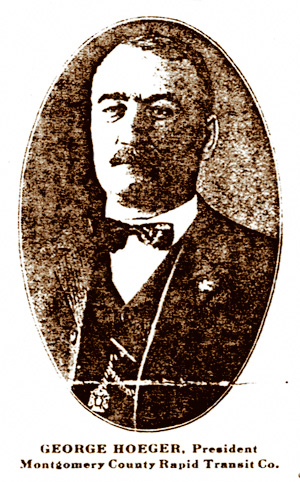
Montgomery County Rapid Transit Company
Its Progress, Location,
and Condition
Reprinted from Philadelphia Record, Tuesday, May 19, 1908.
![]()

Montgomery County Rapid Transit Company
Its Progress, Location,
and Condition
Reprinted from Philadelphia Record, Tuesday, May 19, 1908.
Starting from the largest and one of the prettiest and thriftiest boroughs in the State -- Norristown -- traveling for some distance over an already well patronized line, then turning sharply and passing through the most beautiful and picturesque suburban country adjoining Philadelphia, in covering pleasant distances in the very heart and centre of the richest county in the State, if not in the country -- that is the new Montgomery County Rapid Transit Co.
Headed by capable and cautious business men, well versed in the conduct of such ventures; financed exclusively by the Bankers Corporation Company, of Reading, Pa., spending in Pennsylvania the money taken from the soil of Pennsylvania; its destinies in the hands of home people, well and favorably known among their honest and thrifty neighbors; its course and its business success at the mercy, not of scheming, money-mad plungers, but of wise and conservative, enterprising business men who understand thoroughly the business at hand -- that again is the Montgomery County Rapid Transit Co.
Few interurban trolley lines begin operation under the same auspicious circumstances and with the same wealth of favoring conditions. While other and much less favored sections of the State have been crossed and re-crossed with an absolute network of trolley tracks, this portion of Montgomery county, thickly populated, rich in agricultural products, fitted by nature with scenery well worthy of the tourist, has lain asleep, untouched by the magician's wand of commerce, surrounded by the activities of the world, but not partaking of them, almost as unopened to the markets of the country as Japan before the days of Perry.
Having waited so long for transit facilities, it is only natural and right that those facilities should be of the finest and best when they do appear, and that is what is not contemplated nor proposed, but has actually come to pass.
The new trolley line starts from the very heart of Norristown. It traverses the principal street of the town, under a special agreement with the Schuylkill Valley Traction Company to Trooper. There the new line strikes off at right angles on its own tracks, private right of way and perpetual franchises. On a constantly rising, but gently graded slope, the car approaches Fairview, whence was taken the panoramic photograph shown below.
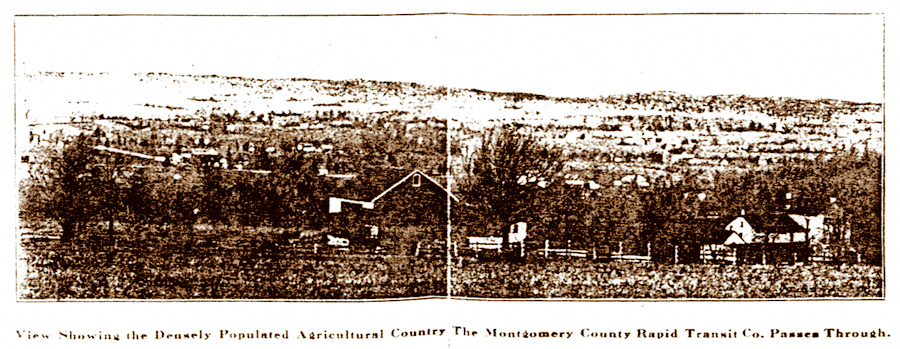
This is but one of the many magnificent vistas of unsurpassed scenery of the gently rolling, well tilled farming land for which this country is widely noted. The forest-crowned hills stand watch and wait over peaceful valleys, green with growing crops and fragrant with odors of flower and fruit blossom. Handsome and well-kept farm houses, substantial barns and outhouses dot the green slopes, houses and barns in good repair and condition. Fences standing erect and strong, carefully pruned orchards, clean farms and gardens, sleek, contented, cattle, well-nourished horses and happy and hospitable people give ample evidence of prosperity and thrift. The whole scene indicates a land flowing with milk and honey, waiting only for the touch of the modern Pygmalion, electricity, to spring into vigorous life.
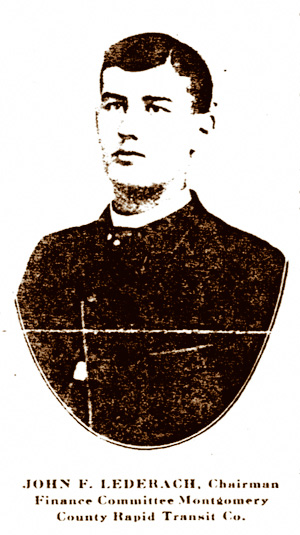 Still steadily mounting, the line reaches the town of Center Point, then on
to Cedars and Skippack. From Skippack to Lederach is another stretch of beautiful
country, noticeable even in that region abounding with charming scenery. There
the line takes a down grade to the considerable town of Harleysville.
Still steadily mounting, the line reaches the town of Center Point, then on
to Cedars and Skippack. From Skippack to Lederach is another stretch of beautiful
country, noticeable even in that region abounding with charming scenery. There
the line takes a down grade to the considerable town of Harleysville.
Despite the fact that the line is constantly rising from leaving Norristown until it reaches Center Point, there is not a grade heavier than four per cent. The grading has been done with the nicest precision, in several places cuts and fills being made to lessen the gradient.
There are a number of fills along the line and several culverts were necessitated by narrow creeks or runs. Just beyond Skippack a considerable bridge was required. Besides the masonry for these places, cuts had to be made in front of a number of private residences. In each case a stone wall was built to retain the land. Not the least wonderful thing about the construction of the line is the characteristic of this masonry. Most of it a dark brown sandstone, being taken from the cuts along the line. The walls, symmetrical and well-pointed have all the appearance of substantiality and seem built to last for centuries. In the case of the larger bridge, stone buttresses and retaining walls are covered with concrete of a snowy whiteness and the bridge itself is of structural iron.
Leaving Trooper the road throughout is built on private right of way. The roadbed is a marvel of neatness and strength. Seventy-five pound rails of the ordinary railroad style are used on the stoutest of locust ties, used at narrow intervals, firmly grounded and ballasted like the best steam railroad. Heavy retaining walls support every fill and cut. The curves are gently and physically correct from an engineering viewpoint, banked to allow of speed.
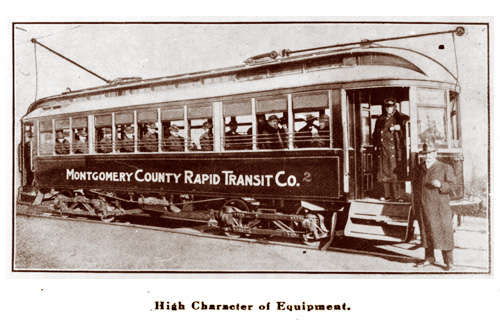
The cars themselves are of the latest pattern. They are dark green in color, with the lettering in gilt and the inside finished in oak. They are of the usual large suburban style, with roomy seats, platforms and aisle. One end is separated by glass partition for smoking compartment. The seats are arranged as in a railway car and are of smooth cane. Electric push buttons at each seat communicate with the platform as a signal to the conductor to stop. The cars are fitted with air brakes and powerful motors capable of giving the cars great speed, which their immense weight will allow without danger.
So much for the physical equipment of the road. Not in all Pennsylvania is there a better built, better equipped or better planned electric railway and certainly none could be more picturesque or attractive or have a more brilliant and profitable future.
Wise, Conservative Management, Its Perpetual Franchises and Private Rights of Way.
As to its management and finances. George Hoeger, the president of the Montgomery County Rapid Transit Company. He is identified with a number of other great business enterprises, all of which have proven successful, and he has the reputation among those who know him of being possessed of great capacity for business and financial sagacity well worth trusting. M. A. Kelley, the vice president, and William C. Riffert, the treasurer, are also prominent Pennsylvanians. John F. Lederach, Chairman of the Finance Committee, is a member of one of the oldest families in the county, for whom Lederach, along the railway line, was named, and he is well known for his shrewdness and capability.
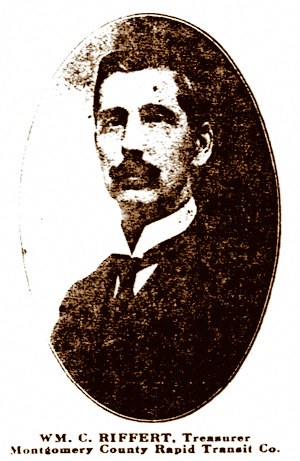 Back of the financing of the company is the Bankers Corporation Company, of
Reading, Pa., of which William S. Lambert is president. Mr. Lambert has had
a wide personal experience in the financing of similar undertakings, especially
in the Middle West, where a number of trolley lines launched by him are now
in the heyday of success. The Bankers Corporation Company engages particularly
in the business of providing capital for the financing of similar enterprises.
Among the western projects financed by this concern is the St. Louis, Webster
& Park Valley Railway, of St. Louis, Missouri, now in a very prosperous
condition. Mr. Lamber had personal supervision of the financial affairs and
the floating of its stocks and bonds.
Back of the financing of the company is the Bankers Corporation Company, of
Reading, Pa., of which William S. Lambert is president. Mr. Lambert has had
a wide personal experience in the financing of similar undertakings, especially
in the Middle West, where a number of trolley lines launched by him are now
in the heyday of success. The Bankers Corporation Company engages particularly
in the business of providing capital for the financing of similar enterprises.
Among the western projects financed by this concern is the St. Louis, Webster
& Park Valley Railway, of St. Louis, Missouri, now in a very prosperous
condition. Mr. Lamber had personal supervision of the financial affairs and
the floating of its stocks and bonds.
The Montgomery County Rapid Transit Company was incorporated with a capital of only $300,000 and bonded for $500,000. These bonds are first mortgage 5 per cent, twenty-year gold bonds in denominations of $200 and $500 each. The mortgage securing this bond issue was drawn by H. M. Brownback, of Norristown, and W. I. Hibbs, of Pittston, as well and favorably known railway corporation attorneys as there are in the State.
The Union Trust Company, of Harrisburg, with its well-known and able Board of Directors and Charles S. Ball, a successful banker and manufacturer as its President, holds the collateral first mortgage railway bonds as trustee. The trustee agreement between the Bankers Corporation Company and the Union Trust Company was drawn by the eminent and well-known railway corporation attorneys, Isaac Heister, of Reading, Pa., and Hon. John. G. Gray, of Wilmington, Del.
The Bankers Corporation Company is a corporation composed of strong, capable and honorable men, and is the oldest company among the hundreds now successfully engaged in the business of providing capital to thoroughly reliable and responsible persons to construct and equip high-grade electric railways that show, beyond question, to be of such character and value that their guarantee on the Collateral Railway Trust Coupon Notes of the Bankers Corporation Company can be offered to the most conservative investor with the assurance that they will absolutely prove profitable to the investor.
These 6 per cent, trust coupon notes The Bankers Corporation Company are offering to the investing public at par with a liberal full paid and non-assessable railway stock bonus free of cost to the investor.
For further information regarding the sale of these collateral coupon notes call on or addr.
BANKERS CORPORATION COMPANY
WILLIAM S. LAMBERT, PRESIDENT
READING, PENN.

One Hundred Years Later
As wonderful as that article is, it does stretch the truth a bit. Calling the area "thickly populated" is a stretch. The map blurs the truth by showing extensions that were never even started, let alone completed, and classifying them as "being graded and in operation." Only the twelve miles from Harleysville to Trooper was built. Claiming that investing in the trolley line with "the assurance that they [20 year bonds] will absolutely prove profitable" wouldn't even be legal by today's standards.
Two years later, a dispute between investors and the gentlemen described in such glowing terms in the 1908 prospectus reached the courts. In February 1910, county judge Weand "removed the Bankers' Trust Corporation from its trusteeship of the trolley company and decreed that it shall deliver to successors, to be hereafter named, all of the papers, moneys or property of any kind" because in Weand's words "the bondholders ... have lost faith in the trustee, who in our opinion ... should renounce their right to act rather than place themselves in a position whereby their good name and credit should be impaired." 1
In November 1911 the trolley emerged from receivership, reorganized as Montgomery Transit Company.
In 1922, the trolley line was foreclosed upon. Reorganized one final time in 1923 as the Skippack & Perkiomen Transit Company, the last day for trolleys was June 7, 1925. Buses took over on a modified route the following day. This would be the first trolley line to be abandoned in its entirety in Montgomery County.
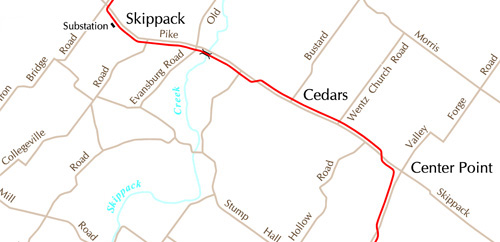
A 1919 list of trolley stops can be found here.
Follow this link to a detailed map of the Montgomery County Rapid Transit Company trolley.
In their authoritative 1968 volume Trolleys of Montgomery County, Harry Foesig and Harold E. Cox have this to say about the Montgomery County Rapid Transit Company:
"It is affectionately remembered by long-time residents as a great convenience never replaced. Unlike so many others, [Montgomery County Rapid Transit Company] did not parallel a railroad and traveled through a section completely without public transportation. Residents of Skippack today, for instance, are five to ten miles away from bus or railroad."
Had the 1916 extension from Harleysville north to Souderton been completed, connection could have been made to the successful Lehigh Valley Transit Company Liberty Bell high speed line. Failing that, the countryside and villages served were too sparsely populated to support transit service.
Click here for an in-depth article about the Montgomery County Rapid Transit Company trolley.
--Mike Szilagyi
1. Ambler Gazette, February 3, 1910
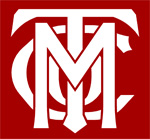
To the Montgomery Transit
Company article
![]()
![]()
Return to Philadelphia Trolley
Tracks main page.